
Babies as young as four months have taste in fine art, study shows
Our taste in fine art can develop from a very early age, researchers have said, after they found babies as young as four months can demonstrate artistic preferences. When shown landscapes by the Dutch post-impressionist painter Vincent van Gogh, psychologists at the University of Sussex found both babies and adults mostly favoured the same paintings, with Green Corn Stalks (1888) proving to be the most popular. The team at the university’s Sussex Baby Lab also uncovered that infants liked paintings that had more edges – such as those featuring leaves or branches – and curved lines. In their findings, published in the Journal of Vision, the researchers said aspects of artistic preferences may be hardwired from an early age. Our study also appears to have identified features of adult aesthetics that can be traced back to sensory biases in infancy Philip McAdams Philip McAdams, a doctoral researcher at the University of Sussex and lead author on the paper, said: “It was fascinating to find that babies respond to the basic building blocks of the paintings, such as edges and colours, and that these properties could explain large amounts of why babies look at, and adults like, particular artworks. “Our study also appears to have identified features of adult aesthetics that can be traced back to sensory biases in infancy. “Our findings show that babies’ visual systems and visual preferences are more sophisticated than commonly thought.” For the study, which was in collaboration with children’s sensory brand, Etta Loves, the researchers recruited 25 babies, aged four to eight months, and 25 adults. The babies sat on their parent’s lap while 40 pairs of images, featuring landscape paintings by Van Gogh, were shown on a tablet. Adults were also shown the same paintings and asked which image in the pair they found to be more pleasant. Recordings showed babies looked longer at the Van Gogh landscapes that adults also rated as most pleasant. These paintings featured high colour and lightness contrasts as well as lots of the colour green. The most preferred Van Gogh painting was Green Corn Stalks whilst the least preferred was Olive Grove (1889). But researchers also found small differences in the artistic tastes between adults and babies. For example, they found that infants preferred paintings that contained the most edges and curved lines, which the adults did not seem to favour. Professor Anna Franklin, head of the Sussex Colour Group and founder of the Sussex Baby Lab, and lead author on the paper, said: “We’ve been amazed by how much the young babies responded to the art. “Although newborn babies’ vision is very blurry, our findings demonstrate that by four months old, babies can see well enough to look longer at some paintings than others, and can pay attention to many of the artistic details.”
2023-08-02 16:16

ADHD symptoms in children can be transformed with brain stimulation therapy
Stimulating the brain using electrodes could help ease symptoms of attention deficit hyperactivity disorder (ADHD) in children, a study has found. Transcranial random noise stimulation (tRNS) works by sending a mild electrical current to the brain through two electrodes on the scalp. The study, led by researchers from the University of Surrey and the Hebrew University of Jerusalem – and published in the Translational Psychiatry journal, explored the use of tRNS alongside cognitive training as a treatment for ADHD. Roi Cohen Kadosh, head of the School of Psychology and professor of cognitive neuroscience at the University of Surrey, said: “I believe that the scientific community is duty-bound to investigate and develop evermore effective and longer-lasting treatments for ADHD.” The clinical trial included 23 newly diagnosed and unmedicated children between the ages of six and 12, who were recruited from groups referred to the ADHD clinic by doctors, teachers, psychologists or parents. Researchers at the computerised neurotherapy lab at the Hebrew University of Jerusalem administered tRNS during cognitive training each weekday over a two-week period. The parents of 55% of the group reported “significant clinical improvement” in ADHD symptoms to researchers, compared to 17% in a control group that was given placebo brain simulation. Prof Kadosh said the findings demonstrate the treatment “has the potential to transform the lives of children and their families”. Future studies, with larger and more varied samples, should help establish this as a viable therapy for ADHD, and help us understand the underlying mechanisms of the disorder Dr Mor Nahum ADHD is a neurodevelopmental disorder and symptoms include hyperactivity, an inability to focus and impulsiveness. According to the National Institute for Health and Care Excellence (Nice), it is present in about 5% of children globally. Researchers are now preparing to start a larger clinical trial using tRNS and cognitive training. “If successful, this approach will be approved as a medical device for ADHD by the United States Food and Drug Administration,” Prof Kadosh said. Dr Mor Nahum is co-lead of the study and head of the computerised neurotherapy lab at the Hebrew University of Jerusalem. She added: “This is an important first step in offering new therapeutic options for ADHD. “Future studies, with larger and more varied samples, should help establish this as a viable therapy for ADHD, and help us understand the underlying mechanisms of the disorder.” Read More Charity boss speaks out over ‘traumatic’ encounter with royal aide Ukraine war’s heaviest fight rages in east - follow live Black LGBTQ+ icons everyone should know Ashley James: ‘We have a totally warped idea of what a mum should be’ Host Maya Jama’s glamorous Love Island outfits cost over £10,000
2023-08-02 15:51
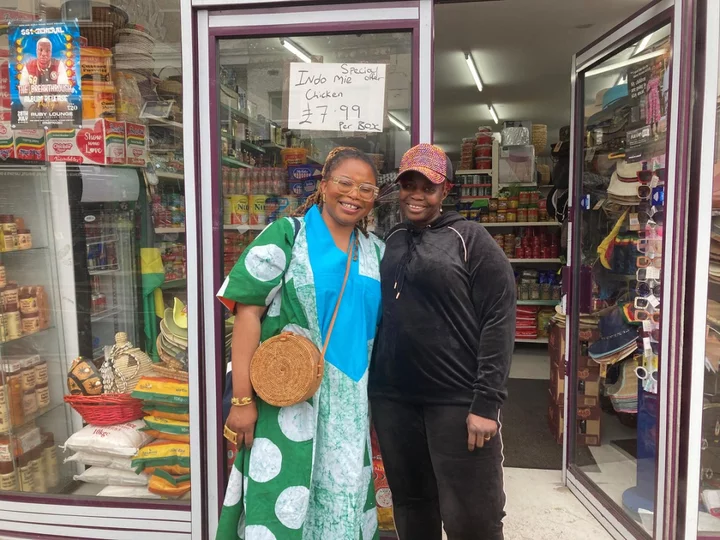
Discovering Sierra Leonean flavours in South London
Chef Maria Bradford remembers the first time she came to Peckham market. Originally from Sierra Leone, she moved to England in her late teens, and after four years she was desperately homesick. She was living in Kent and felt far removed from her home of Freetown – until she went to Peckham in South London. “The first time I ever came to Peckham, it was such a shock. I didn’t think a place existed like that [in England] – it reminded me so much of the hustle and bustle in Freetown,” she says. “All of a sudden, you get off the train and you come to this place and you’re like, Oh my God. I’m home.” Bradford, now 42, says she “desperately needed” a place like Peckham, and has been coming to the market regularly ever since. We’re back there today – on a hot but overcast London day, and Bradford is showing me how to pick out the best Sierra Leonean ingredients. We go on a weekday, as she says a weekend would take us a lot longer to get round, once she’s spoken to all the aunties in the community who want a chat. As we walk through the market, Bradford starts talking about Sierra Leonean cuisine. “I would say it’s quite healthy. We eat lots of leaves and greens, and we eat a lot of seafood as well. There’s lots of layers to Sierra Leonean food, because we mix things like smoked fish and meat in the same dish… Because we use fish more as a flavouring.” The words that spring to mind when she thinks about the food of her homeland? “Healthy, homely, comforting.” Bradford continues: “I don’t know if that’s because I’m Sierra Leonean, it brings me that calmness and home feeling. That warmth. It feels like I’m sitting at the back of our house with my mum, my nan, my grandmother, my aunties and everyone – we’re sitting around cooking, and it feels like comfort.” When she really wants to feel comforted and soothed, Bradford whips up a bowl of egusi soup (egusi – also known as melon seeds – is a thickener, and the recipe includes oxtail, goat meat, white sorrel, smoked barracuda and Scotch bonnet chillies) that Bradford says is like a “food hug, because when you eat it all you want to do is sleep”. After looking at some of the outdoor stalls full of colourful produce – bright pumpkins, squat varieties of cucumber, browning plantains – we go into Bit By Bit, a Sierra Leonean shop run by Sarian Karim-Kamara. Karim-Kamara immediately starts singing Bradford’s praises (“you’re flying the Sierra Leonean flag – we’re so proud of you!”) and thumbing through her new cookbook, called Sweet Salone – a nickname for the country. The shop is full of speciality ingredients you’ll need to make some of the recipes in the book – from the brightly coloured red palm oil (a staple in the country) to frozen cassava leaves and smoked barracuda. Bradford is keen to promote local shops such as this one, saying: “People are really friendly and want to talk about the ingredients – they don’t just know about the ingredients, they know what to do with it, how to promote it… It’s nice to step into these shops and have conversations, because you might learn so much more than what you bargained for.” As well as running the shop, Karim-Kamara is an FGM campaigner – she’s just launched a new campaign with the Mayor of London – and runs a food bank out the back. “For three years I’ve been supporting refugees and asylum seekers, but the food bank is open now to the community because everyone is struggling,” she says. Karim-Kamara adds she doesn’t talk much about it because “some people are really shy… The way we do the service is people come to the back and help themselves”. We move onto another shop selling West African ingredients – including jute leaves, black velvet tamarind and white hibiscus – and Bradford strikes up a conversation with the shopkeeper, who says she’ll pre-order the cookbook and give it to her daughter, so traditional Sierra Leonean cooking continues down the generations. “The children that are born here, they don’t really know how to cook the traditional stuff,” Bradford says after this exchange. “They’ll be more gearing towards the Afro-fusion side. It’s really important we keep the core traditional stuff, and also keep it separate.” But Bradford is an advocate for Afro-fusion dishes as well, describing it as “taking traditional Sierra Leonean ingredients and using techniques we wouldn’t necessarily use to extract as much flavour from those things”. After working as an accountant for 10 years (which she hated), Bradford did an evening course at prestigious cooking school Leiths and set up a catering company, and now uses her classical training to give a spin on the dishes she grew up eating. Examples of Afro-fusion recipes in the book include cassava chips with truffle and Parmesan, and the oxtail pepe stew – which has red wine added, a French technique she drew upon to deepen the flavours. Whether it’s traditional dishes or Afro-fusion flavours, Bradford – who is still based in Kent – uses cooking to connect with her roots. It started when she first moved to the UK and was missing home. “So I started cooking, making stuff I like to eat with stuff I can get my hands on,” she says. One of the first dishes she made was peanut soup (“you can get peanut butter anywhere, and you can pick up chicken anywhere”) and it grew from there. “Cooking and throwing those things together to feel like you’re home, connecting back to Sierra Leone.” ‘Sweet Salone’ by Maria Bradford (Quadrille, £30). Read More A week’s worth of summery recipes (even when the weather is dire) The dish that defines me: Frank Yeung’s prawn wontons How to make cassava chips How to make a traditional Sierra Leonean rich cake How to make West African brasied beef shorts in peanut and coconut milk In Horto: Hearty, outdoorsy fare in a secret London Bridge garden
2023-08-02 13:54
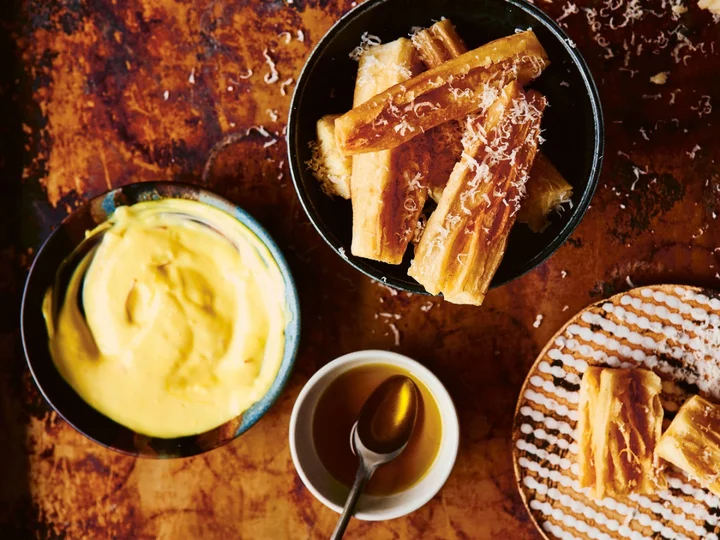
How to make cassava chips
If you are not familiar with cassava, it is tuber with a waxy, bark-like outer skin and a starchy centre,” explains Maria Bradford, author of Sweet Salone. It’s a staple in Sierra Leonean households, and Bradford adds: “This recipe combines my beloved cassava with European ingredients, such as Parmesan and truffle. “The flavour is every bit as good as potato chips, if not better, with just the right subtle hint of earthy truffle. They’re crispy on the outside, tender on the inside, perfectly salted and mixed with Parmesan to take them over the top. A simply luxurious snack!” Cassava chips with truffle oil, Parmesan and saffron mayo Serves: 6-8 Ingredients: For the cassava chips: 1kg cassava 1 tsp sea salt 60g parmesan, grated Sunflower oil, for deep frying Parmesan shavings, to serve 3 tbsp white truffle oil For the saffron mayo: Large pinch of saffron 2 tbsp hot water 300g good-quality mayonnaise 1-2 cloves garlic, finely chopped Method: 1. To peel the cassava, cut the cassava crosswise into five to eight-centimetre pieces. Using a sharp knife, cut lengthwise through the bark-like exterior and into the pink skin beneath. Place the tip of the knife under the skin to loosen it and pull off the skin and bark. Cut into chunky chip-sized pieces. 2. As you work, rinse the cassava and put the pieces in a large saucepan with cold water so it doesn’t discolour. When all are cut to size, add the salt and bring the pan of water to the boil. Boil until the cassava pieces are tender when pierced with a knife, about 25 minutes. 3. Meanwhile, make the saffron mayo. Crumble the saffron threads into a small bowl and pour over the hot water. Let it steep for 10 minutes. 4. Stir the mayonnaise and garlic together in a bowl. Add the saffron water and stir to combine. Taste and season with salt. 5. When the cassava is tender, drain it in a sieve and set aside until completely dry. 6. Heat the oil for frying in a deep, heavy-based pan no more than half full. To test if the oil is hot enough, drop a small breadcrumb into the hot oil. It should sizzle and turn brown in 20 seconds. 7. Working in small batches so as not to overcrowd the pan, fry the cassava chips until nicely golden, five to 10 minutes per batch. Remove with a slotted spoon and drain on a baking sheet lined with paper towels. 8. Toss the fried cassava chips with grated Parmesan and the white truffle oil. Serve with the saffron mayo on the side. ‘Sweet Salone’ by Maria Bradford (Quadrille, £30). Read More A week’s worth of summery recipes (even when the weather is dire) The dish that defines me: Frank Yeung’s prawn wontons Discovering Sierra Leonean flavours in South London How to make a traditional Sierra Leonean rich cake How to make West African brasied beef shorts in peanut and coconut milk In Horto: Hearty, outdoorsy fare in a secret London Bridge garden
2023-08-02 13:52
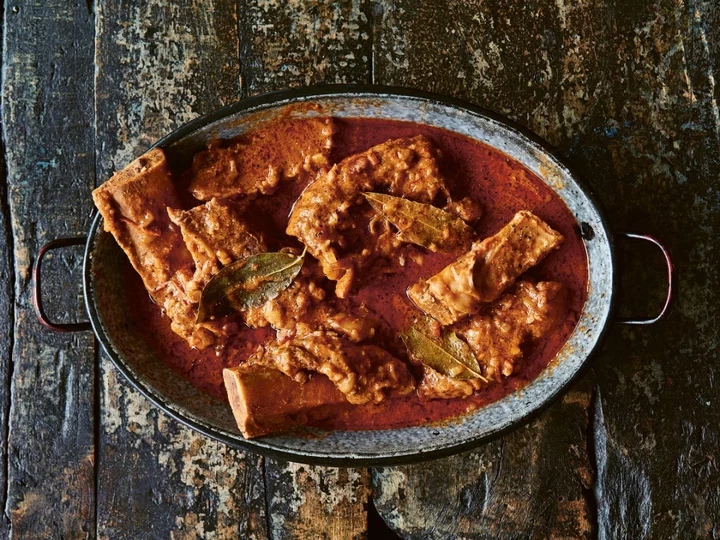
Low and slow: Braised beef short ribs in peanut and coconut milk
The coconut is a truly tropical fruit, which spread on its own to tropic coastal zones all over the world. The flesh and milk from coconuts are widely used in African cooking in relishes, sauces, desserts – you name it,” says Maria Bradford, author of Sweet Salone. Braised beef short ribs in peanut and coconut milk Serves: 5 Ingredients: 5 beef short ribs 2 tbsp sunflower oil Steamed coconut rice or fonio, to serve Salt For the peanut and coconut sauce: 2¼ tsp cumin seeds ¾ tbsp coriander seeds 1 tsp West African Pepper Blend (see below) ¾ tbsp curry powder 3½ tbsp coconut oil 2½-3 large onions, finely chopped 25g garlic, grated 25g ginger, grated 1-2 Scotch bonnet chillies, seeds left in, finely chopped 45g tomato purée 250g fresh tomatoes, chopped ½ tsp coconut sugar 300ml coconut milk 3 bay leaves 3 thyme sprigs 100g unsalted smooth peanut butter (use one without palm oil) 500ml beef stock For the West African pepper blend: 2½ grains of paradise 2 tbsp black peppercorns 2 tbsp white peppercorns 1 tbsp cubeb pepper 3 tbsp allspice berries Method: 1. For the West African pepper blend: toast all the peppercorns in a dry pan over medium heat until fragrant. Allow to cool, then grind in a spice grinder or pestle and mortar. Store in an airtight jar. It will stay fresh for up to three months. 2. Preheat the oven to 150C/130C fan/300F/gas mark 2. 3. For the sauce, lightly toast the cumin and coriander seeds in a hot, dry frying pan until aromatic. Grind in a pestle and mortar or food processor, combine with the West African Pepper Blend and curry powder and set aside. 4. For the short ribs, heat the sunflower oil in a large frying pan over high heat. Season the short ribs with salt and add to the hot pan, frying on each side until golden brown, turning regularly. The aim here is not to cook them but to sear them and add flavour. Make sure to brown them well all over, then remove and set aside. 5. For the sauce, heat the coconut oil in a large heavy-based casserole or Dutch oven (use one with a lid). Add the onions and cook gently over low-medium heat until caramelised and very sweet. This will take up to 30 minutes and it’s important not to rush this process. Add the garlic, ginger and chillies and cook, stirring, for five minutes more. Add the spices and cook for a further five minutes on low heat, stirring to prevent sticking. 6. Add the tomato purée, chopped tomatoes, coconut sugar, coconut milk, bay leaves, thyme sprigs, peanut butter and beef stock to the pan. Stir well to combine, bring to the boil then add the short ribs to pan, making sure they’re all covered by the sauce. 7. Cover with the lid and cook in the oven for four to five hours or until the meat is tender and falling off the bone. Remove from the oven, taste and add salt if needed. Serve with steamed coconut rice or fonio. ‘Sweet Salone’ by Maria Bradford (Quadrille, £30). Read More A week’s worth of summery recipes (even when the weather is dire) The dish that defines me: Frank Yeung’s prawn wontons Discovering Sierra Leonean flavours in South London How to make cassava chips How to make a traditional Sierra Leonean rich cake In Horto: Hearty, outdoorsy fare in a secret London Bridge garden
2023-08-02 13:46
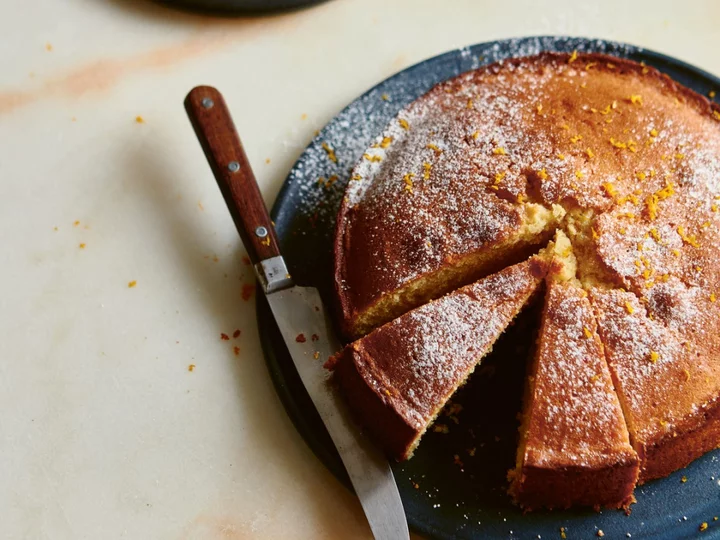
How to make a traditional Sierra Leonean rich cake
I have fond childhood memories of the preparation process involved in making this cake,” says Maria Bradford, author of Sweet Salone. “We would often cream the butter and sugar by hand using a wooden spoon in Sierra Leone and this could take hours, but the end result was worth it. The next step is where Sierra Leonean ingenuity comes in. We would butter the inside of empty powdered milk tins and use these as baking tins. “The cake was then baked outside in the open on an improvised oven, with a large pot placed on top of three stones, with sand spread across the base. We put the cake tins on top of the hot sand in the pot and put the lid on. Our fuel was wood or charcoal, and when the fuel was very hot, we put lumps of hot charcoal on top of the lid of the pot to brown both the top and bottom of the cake.” Sierra Leonean-style rich cake Serves: 6-8 Ingredients: 150g butter, plus extra for buttering 150g caster sugar 3 eggs 50g plain flour 150g self-raising flour 1-2tbsp full-fat milk Finely grated zest of 1 orange 1 tsp natural orange flavouring (I use Steenbergs’ Organic Orange Extract) Method: 1. Make sure all the ingredients are at room temperature. Generously butter an 18-centimetre cake tin. Preheat the oven to 180C/160C fan/350F/gas mark 4. 2. Using an electric hand-mixer, cream the butter and sugar together in a large mixing bowl until the mixture is pale, light and fluffy (10-15 minutes). Don’t rush this step; the more thoroughly the butter and sugar are combined, the lighter the cake will be. Add the eggs, one at a time, beating the mixture well between each addition. Add one tablespoon of flour with the last egg to prevent curdling. 3. Sift both flours into the bowl and gently fold in, adding just enough milk to give a mixture that drops slowly from a spoon when the spoon is held away from the bowl. Fold in the orange zest and orange flavouring. 4. Pour the batter into the prepared tin and bake for 30-40 minutes, or until golden-brown on top and a skewer inserted into the centre comes out clean. 5. Turn the cake onto a cooling rack and leave to cool. Slice and enjoy. ‘Sweet Salone’ by Maria Bradford (Quadrille, £30). Read More A week’s worth of summery recipes (even when the weather is dire) The dish that defines me: Frank Yeung’s prawn wontons Discovering Sierra Leonean flavours in South London How to make cassava chips How to make West African brasied beef shorts in peanut and coconut milk In Horto: Hearty, outdoorsy fare in a secret London Bridge garden
2023-08-02 13:45

Paris robbery: Smartly dressed gang stage €10m jewellery raid
Two men in suits and a woman wearing a dress target a store in a street full of luxury jewellery shops.
2023-08-02 01:57

TikTok viewers spark debate over whether or not to wash chicken - so who’s right?
A TikTok creator’s video sparked debate over whether or not chicken should be washed before it’s cooked. Zoe Barrie (@zoebarrie) posted a video, which has now reached over 3.4m views, on 17 July to reveal her step-by-step process for cooking “spatchcocked roast chicken.” Though the footage was one minute and 23 seconds long, skeptical followers were only concerned with the first 30 seconds: the prep work. Barrie was seen unpackaging a full raw chicken, taking out the guts, and cutting it open. She moved the meat to a wired tray and sprinkled it with salt crystals. Barrie proceeded to place the bird in her fridge before blotting it with a paper towel and searing it in a pan. Immediately, critics flooded the woman’s comment section to question her methods. “Wait, no wash?” one TikTok user asked, while another added: “Um, did you wash it first, though?” “Don’t you rinse before cooking?” one person questioned. Among the suspicious users, kind followers came to Barrie’s defense when they didn’t believe that washing chicken wasn’t necessary. “Washing chicken is as stupid as washing your bread,” one individual wrote. “These washing meat comments are sending me. Y’all are so silly,” another woman remarked. Despite the overwhelming number of individuals who argued raw poultry needs to be rinsed, the Food Safety and Inspection Service (FSIS) advises against it. The FSIS warned that washing chicken leads to the spread and cross-contamination of bacteria and “poultry juices” onto other food and surfaces. Water also won’t “destroy” bacteria like Salmonella or Campylobacter, and “only cooking will destroy any bacteria that might be present on fresh chicken.” @zoebarrie spatchcocked roast chicken ftw ? (crispy chicken ib cooking school and samin nosrat & lemon chimichurri ib me) #roastchicken #salt ♬ Wes Anderson-esque Cute Acoustic - Kenji Ueda Cross-contamination increases the risk of food poisoning, according to the FSIS. “This can occur if raw poultry or its juices come in contact with cooked food or foods that will be eaten raw, such as salad,” the report read. Per the 2019 Food Safety Consumer Research Project analysis, individuals who washed their chicken in the sink were more likely to contaminate their produce due to the bacteria left on the surface. The Minnesota Department of Health noted that, even if you wash chicken in a “slow stream of water,” risky germs are still able to splash on to fresh food or other dishes. Although most reports advise against soaking or rinsing poultry, some people still prefer to do so. In this case, the Centers for Disease Control and Prevention put together a list of recommendations for how to safely clean the raw food. First, chefs shoud “run the water gently over the chicken to reduce splashing”. Then, immediately clean the sink and area around the sink with hot soapy water and sanitise it thoroughly. After handling raw poultry, people should also wash their hands for 20 seconds. Barrie went on to let the chicken brown in a pan and bake in the oven. Finally, she garnished the meat with a chimichurri-like spread. The Independent has reached out to Barrie for a comment. Read More Child wiping their hands on wedding dress sparks debate in viral TikTok People are surprisingly divided over burrata as debate oozes online Woman claims restaurant ‘hack’ for toddlers solves family dinners out
2023-08-02 00:52

Ashley James: ‘We have a totally warped idea of what a mum should be’
Ashley James says there’s “a total lack of understanding” about feeding babies – and that mothers who pump shouldn’t have to hide away. “With pumping, people should feel confident, just like with breastfeeding, to do that anywhere,” says the DJ and influencer. “If anyone were to have a problem with that, they need to address some deep-rooted issues of why feeding a child would be a problem.” James, who has a two-year-old son, Alfie, and a four-month-old daughter, Ada, with partner Tommy Andrews, argues there’s a huge lack of knowledge about how all-consuming feeding a child with breast milk is – from the hours spent feeding or pumping (an estimated eight to 12 times a day, up to 45 minutes each time for newborns) and “also the fact that you can’t just leave your child”. The 36-year-old says: “People don’t really know about engorgement, mastitis, blocked ducts, supply issues, and all the reasons that people choose to pump.” For example, going back to work. “[People think] ‘Oh just give them a bottle or pump in the morning, and then they’ll be fine’. There’s a total lack of awareness.” The former Made In Chelsea star, who hit the headlines after breastfeeding Alfie live on the Jeremy Vine Show in 2021, is currently using a pump alongside breastfeeding Ada for her to have the option of a bottle, too. “I ended up having to breastfeed [on TV] and there was this really weird backlash – people saying it was attention seeking. [Which is] funny to me. Let’s say that was my plan, I’m a total narcissist and I’d decided this was going to be my chance to get publicity… how would I have managed to convince my three-month-old baby to feed at that exact moment? “Who would I want attention from? Is it because our ‘boobs are for men’ and therefore I’m hoping that men might look at my boobs, because I’ve never wanted that, but I especially don’t want that when I’m feeding my child. I think we have this totally warped idea of what a mum should be. “We are always told, they’re the most important years of a children’s life, those early years, and it’s so formative, but yet I feel like we expect mums to almost keep their children hidden away, but then we expect them to thrive.” On Channel 4’s Steph’s Packed Lunch last month, James used an Elvie Stride breast pump live on air – unbeknownst to viewers and crew. The discreet hospital-grade, hands-free, electric device can be worn under clothing to pump milk without anyone noticing. “I was worried about having blocked ducts and didn’t want to go back to that horrible situation of having mastitis again,” she says. James had the condition when breastfeeding her son two years earlier. “I just wanted to get on with my job, but I needed to deal with the engorgement issue. “It was almost behind the scenes. I was having this huge [issue] with my health – but us mums tend to just get on with the job. “In terms of pumping, I don’t know why we feel like as a society that any form of feeding should be done in private, especially if it’s not bottle feeding. Hats off to all the people who exclusively pump because it’s so constant. She believes it should be celebrated as much as breastfeeding because “it’s really hard to manage, people don’t know the logistical nightmare of it all. “You just don’t see anyone pumping, but you know that people are doing it. So why is it that people are stuck at home? “Obviously lots of people who are trying to feed have to go back to work, for various reasons – maternity pay or maternity leave not being long enough,” she adds. In fact, James started working again, on photoshoots and TV, just five days after the birth of Ada. “I’m self-employed, I don’t get maternity leave – you do what you have to do,” she says. These days she shrugs off negative comments online, but James has experienced real-world shaming for public feeding too. “I was in a children’s attraction in London, breastfeeding Alf, and a member of staff came up to me and asked me to move into the loos. I was like, this is a child-friendly attraction space! “[I said] ‘No, would you eat in a public loo?’. I don’t even want to go to the loo in a public loo, never mind feed my child there!” Ashley James is an ambassador for Elvie. Find out more information about the Elvie Stride at elvie.com. Read More Charity boss speaks out over ‘traumatic’ encounter with royal aide Ukraine war’s heaviest fight rages in east - follow live Host Maya Jama’s glamorous Love Island outfits cost over £10,000 Do you need to watch what you eat when you’re breastfeeding? Sten dos: What you need to know about the quirky wedding trend
2023-08-01 21:26

Need to Repair an Xbox Controller? Microsoft Will Sell You the Parts
Microsoft is expanding its self-repair program to include Xbox controllers. As The Verge reports, Microsoft
2023-08-01 19:59

Do you need to watch what you eat when you’re breastfeeding?
Most new mothers try to breastfeed their baby at first, unable to ignore the oft-repeated mantra ‘breast is best’. However, despite the vast benefits of breastfeeding that are being highlighted during World Breastfeeding Week (August 1-7), including protecting the baby from infection and disease, and health benefits for the mother, a huge proportion of mothers quickly give up. Figures from the last UK-wide Infant Feeding Survey (albeit from 2010) found that while more than three-quarters of women start breastfeeding when their baby’s born, this drops to 55% doing any breastfeeding at six weeks, while at six months, just 34% do any breastfeeding, and only 1% breastfeed exclusively. There are many reasons for this, but Public Health England research found more than half of mothers were concerned they might need a special diet to breastfeed, and a similar proportion were worried that breastfeeding meant they couldn’t tell if their baby was getting too much or too little milk. But should new mums really be concerned about eating or not eating specific foods if they’re breastfeeding, and can their diet affect how much milk their baby’s getting? The simple answer is no, as long as they’re eating a healthy balanced diet, says the baby charity Tommy’s. Because while the NHS warns pregnant mothers to avoid specific foods like soft blue cheeses, undercooked meat, liver, pâté and game meats, there are no foods breastfeeding mums must not eat, says Tommy’s. “There are a lot of myths out there around breastfeeding which can leave new parents unsure of what to do and where to turn,” says Tommy’s midwife Sophie King. “If you choose to breastfeed or combination feed, there’s no special foods you need to have, but a varied diet can help our bodies make the best quality milk for our babies. This typically includes lots of vegetables, fruits, grains and proteins. It’s also important that you stay well-hydrated with plenty of water. “ In addition, she says it’s recommended that mothers who are exclusively breastfeeding take a daily vitamin D supplement. An occasional alcoholic drink is unlikely to cause any harm if you’re breastfeeding, says King, but she warns: “Try not to have more than one or two units of alcohol once or twice a week. There’s some evidence that regularly drinking more than two units of alcohol a day while breastfeeding may affect your baby’s development.” In addition, caffeine can reach babies through breast milk, and King explains: “Caffeine is a stimulant, so if you have a lot, it may make your baby restless and keep them awake.” Caffeine occurs naturally in lots of foods and drink, including coffee, tea and chocolate, and it’s also added to some soft drinks and energy drinks, as well as some cold and flu remedies. “There’s not enough information to say how much caffeine is too much, and babies respond to caffeine differently,” says King. “But it’s a good idea to reduce how much caffeine you drink, especially when your baby is less than six months old.” But does what a mother eats affect her milk supply? Again, the answer is no, explains Justine Fieth of the breastfeeding support charity La Leche League GB (LLLGB). “There are no particular foods you need to eat to increase breastmilk – milk production is determined by the amount of milk removed from the breast,” she says. Breastmilk is made in the mother’s breasts, directly from her blood, rather than from the food she eats. Fieth says LLLGB recognises the importance of a varied and healthy diet, and stresses that it’s important for mothers to speak to a qualified breastfeeding supporter if they feel they have low milk supply. “Unless there’s a physical or physiological reason for low milk production, a mother who breastfeeds on cue will be able to produce enough milk for her baby, regardless of what she eats,” she explains. “In certain circumstances, medications can be used to increase supply, but diet plays a minor part – though obviously, eating a varied, healthy diet is always a good thing.” For breastfeeding support, contact the National Breastfeeding Helpline on 0300 100 0212. Read More Charity boss speaks out over ‘traumatic’ encounter with royal aide Ukraine war’s heaviest fight rages in east - follow live Sten dos: What you need to know about the quirky wedding trend Why have the birds disappeared from my garden? Psoriasis Awareness Month: Everything you need to know
2023-08-01 17:26
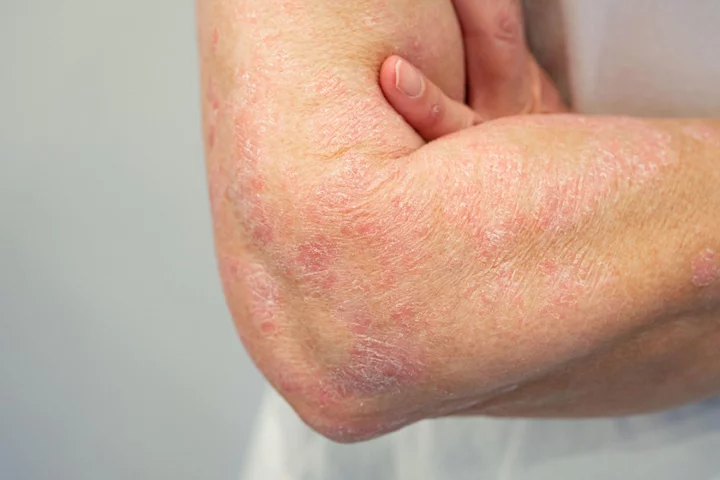
Psoriasis Awareness Month: Everything you need to know
Psoriasis has been a hot topic in the health world in recent years, thanks in part to one very vocal – and very famous – celebrity. Kim Kardashian has shared the ups and downs of her experience with the skin condition on TV and social media, and penned a piece on the subject for her sister Kourtney’s website Poosh. “When I was 25, I had my first psoriasis flare-up,” the reality star and entrepreneur wrote. “I got a common cold, and since psoriasis is an autoimmune condition, this triggered it. It was all over my stomach and legs.” After an injection of cortisone recommended by a dermatologist, the symptoms went away for five years, but came back when Kardashian was in her 30s. “Psoriasis can start at any age, but most often develops in adults between 20 and 30 years old, and between 50 and 60 years old,” says Dr Nisa Aslam, a GP from Typharm’s Skin Life Sciences Foundation. “The severity varies greatly. For some people, it may be relatively minor, whilst for others, psoriasis has a huge impact on quality of life.” In the case of Kardashian, her psoriasis – which has no known cure – also went away during her two pregnancies, but came back after and has fluctuated ever since. “I’ve become extremely comfortable with my psoriasis,” she continued in her essay, revealing that sometimes she covers it up with body make-up and sometimes she doesn’t. “I hope my story can help anyone else with an autoimmune disease feel confident that there is light at the end of the tunnel.” To mark Psoriasis Awareness Month in August, these are the key facts you need to know about the chronic condition… What are the symptoms of psoriasis? “Psoriasis is a type of skin disease that affects about 2% of the population of the UK,” says consultant dermatologist Dr Natalia Spierings, author of Skintelligent: What You Really Need To Know To Get Great Skin. “Patients develop thickened red plaques of skin with thick silvery white scale over the top.” The most common places for plaques to appear are the backs of the elbows, the front of the knees, the scalp and the lower back. They may be itchy or painful. “On brown and black skin, the patches can also be purple or dark brown in colour, and the scales may look grey,” says Aslam. Psoriasis is also linked with an inflammatory form of arthritis, known as psoriatic arthritis, which Kim Kardashian was diagnosed with in 2019. Aslam explains: “Psoriatic arthritis affects the nails, joints and can affect the eyes, the cardiovascular system and may cause insulin resistance, leading to diabetes.” What is it caused by? “Psoriasis is an ‘immune-mediated’ disease, which means that the skin is inflamed, due to a dysfunction or abnormality in how the immune system works,” Spierings says. Doctors believe that an overactive immune system speeds up skin cell turnover, which causes plaques. “Normal skin cells will grow and then shed off the top of the surface of the skin in a cycle which takes approximately a month,” Spierings continues. “In psoriasis, this process is sped up to only three or four days, so the skin doesn’t have time to shed off, and therefore the scale builds up on the skin.” Diet and lifestyle factors can cause flare-ups of the condition. “Known triggers include drinking excessive alcohol; family history; smoking; stress and hormonal changes, for instance during puberty and menopause,” says Aslam. “Plus certain medicines such as betablockers, used to treat high blood pressure; throat infections; other immune disorders and skin injuries. Obesity has been shown to double the risk of psoriasis.” What treatments are available? While there is no cure for the chronic condition, it is possible to treat the symptoms during flare-ups. “There are a variety of effective prescribed skin treatment options, from steroid ointments and creams, to the development of new formats like medicated tapes such as Fludroxycortide tape,” says Aslam. “This is a transparent medicated surgical tape impregnated with the steroid Fludroxycortide, which can be cut to size. When applied to the skin, it helps to reduce redness, swelling and itching.” UV light or sun exposure has also been shown to help psoriasis. “But remember that uncontrolled sun exposure also increases your risk of skin cancer and premature ageing,” says Spierings. “If you want to use sunlight therapy for your psoriasis, it is best to do this via a dermatologist using special machines to deliver the UV treatment.” Because it’s an inflammatory condition, psoriasis can be affected by what you eat. “Certain foods, particularly ultra-processed foods high in fat, salt and sugar may cause an inflammatory response,” says Aslam. “It’s important to stick to a healthy diet with plenty of vegetables, fruits, wholegrains, beans and lentils, and oily fish with small amounts of lean meat, and small amounts of dairy if liked.” She adds: “Finding the most effective therapy is often a matter of trial and error, so it’s important to keep going back to your doctor, or dermatologist, for advice.” Psoriasis and mental health It’s important to note that skin conditions like psoriasis can have a detrimental impact on mental health. “A recent Typharm survey found that 23% of those surveyed think others believe they are infectious and 19% think they are perceived as unhygienic,” Aslam says. However, it is not contagious or caused by poor hygiene. “Patients with psoriasis have a high risk of developing depression because of their skin problem,” says Spierings. “It is incredibly important to seek proper treatment if you have psoriasis or think you may have it.” Read More Charity boss speaks out over ‘traumatic’ encounter with royal aide Ukraine war’s heaviest fight rages in east - follow live How to dress in rainy summer weather How to make the Prince of Wales’s Earthshot burger 13 potential cancer symptoms you should get checked out
2023-08-01 15:28
